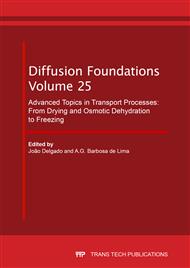[1]
J.B. Silva, Simulation and experimentation of the drying of hollow ceramic bricks. Doctoral Thesis in Process Engineering, Federal University of Campina Grande, Campina Grande, Brazil, 2009, 198 p. (In Portuguese).
DOI: 10.21475/ajcs.2016.10.10.p7455
Google Scholar
[2]
M.H.F Medeiros, D.J. Souza, J.H. Filho, C.S. Adorno, V.A. Quarcioni, E. Pereira, Red-clay waste and limestone filler added in Portland cement composite: effects on sulfate attack and alkali-silica reaction. Matéria, 21(2) (2016) 282 – 300.
Google Scholar
[3]
I.O. Martins, M.B. Quadri, V. P. Nicolau, F. Miotto, Simulation of the convective drying of a red clay brick. COBEQ - XXI Brazilian Congress of Chemical Engineering. Fortaleza, Brazil, 2016. 8p. (In Portuguese).
Google Scholar
[4]
J.B. Silva, Drying of industrial ceramic blocks: modeling, simulation and experimentation. Doctoral Thesis in Process Engineering, Federal University of Campina Grande, Campina Grande, Brazil, 2018. 187 p. (In Portuguese).
DOI: 10.21475/ajcs.2016.10.10.p7455
Google Scholar
[5]
J.J.S. Nascimento, F.A. Belo, A.G.B. Lima, Experimental Drying of Ceramics Bricks Including Shrinkage, Defect and Diffusion Forum, 365 (2015) 106-111.
DOI: 10.4028/www.scientific.net/ddf.365.106
Google Scholar
[6]
J.B. Silva, G.S. Almeida, W.C.P.B. Lima, G.A. Neves, A.G.B. Lima, Heat and mass diffusion including shrinkage and hygrothermal stress during drying of holed ceramics bricks, Defect and Diffusion Forum. 312-315 (2011) 971-976.
DOI: 10.4028/www.scientific.net/ddf.312-315.971
Google Scholar
[7]
G.S. Almeida, F.V.S. Tavares, W.M.P.B. Lima, A.G.B. Lima, Energetic and Exergetic Analysis of the Clay Bricks Drying in an Industrial Tunnel Dryer, Defect and Diffusion Forum, 369 (2016) 104-109.
DOI: 10.4028/www.scientific.net/ddf.369.104
Google Scholar
[8]
G.S. Almeida, J.B. Silva, C. J. Silva, R. Swarnakar, G.A.N. Neves, A.G.B. Lima, Heat and mass transport in an industrial tunnel dryer: Modeling and simulation applied to hollow bricks. Applied Thermal Engineering, 55 (2013) 78-86.
DOI: 10.1016/j.applthermaleng.2013.02.042
Google Scholar
[9]
W.P. Silva, C.M.D.P.S. Silva, L.D. Silva, V.S.O. Farias, Drying of clay slabs: Experimental determination and prediction by two-dimensional diffusion models. Ceram. Int. 39 (2013) 7911-7919.
DOI: 10.1016/j.ceramint.2013.03.053
Google Scholar
[10]
M.V. ARAÚJO, R.S. SANTOS, R.M. SILVA, J.B.S. NASCIMENTO, W.R.G. SANTOS, A.G.B. LIMA, Drying of Industrial Hollow Ceramic Brick: A Numerical Analysis Using CFD. Defect and Diffusion Forum, 391 (2019) 48-53.
DOI: 10.4028/www.scientific.net/ddf.391.48
Google Scholar
[11]
M.V. Araújo, R.S. Santos, R.M. Silva, A.G.B. Lima, Drying of Industrial Hollow Ceramic Brick: Analysis of the Moisture Content and Temperature Parameters. Defect and Diffusion Forum, 380 (2017) 72-78.
DOI: 10.4028/www.scientific.net/ddf.380.72
Google Scholar
[12]
Manual Ansys CFX 15.1, (2015).
Google Scholar
[13]
Y.A. Çengel, J.J. Ghajar, Heat and Mass Transfer: a practical approach. 4th edition –AMGH Editora Ltda. Porto Alegre, (2012).
Google Scholar
[14]
M.K.T. Brito, Theoretical Study of Heat and Mass Transfer on the Ceramic Bricks Drying with paralelepipedic shape. Master's dissertation in Mechanical Engineering, Federal University of Campina Grande, Campina Grande, Brazil, 2016. 111 p. (In Portuguese).
DOI: 10.21475/ajcs.2016.10.10.p7455
Google Scholar


